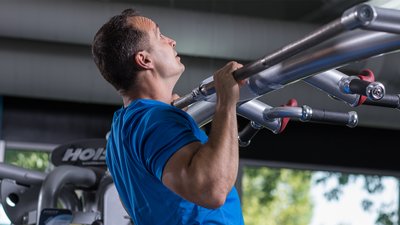Q: If I can't do a pull-up at age 40-plus, is it worth bothering to learn, or is the lat pull-down enough?
Pull-ups are an emotionally loaded movement for many people. Maybe you used to be able to do reps in bunches, but now get stuck at 3 like a broken clock. Maybe you could never do them, or do them well, and it's stuck in your craw ever since. Either way, it can be a sensitive issue. So let's tackle the question head on.
No, you don't need to put a pull-up bar in your kitchen and do reps every damn day like Travis Bickle in order to be "fit" or "strong" in my book. But if we tweak the question slightly, to "Should I be able to do pull-ups?" the answer changes.
Whether or not you actually should do pull-ups with any regularity in your training, I would argue you should at least be able to do them. And I don't mean only one rep, although that's a worthy short-term goal if you currently can't do one at all.
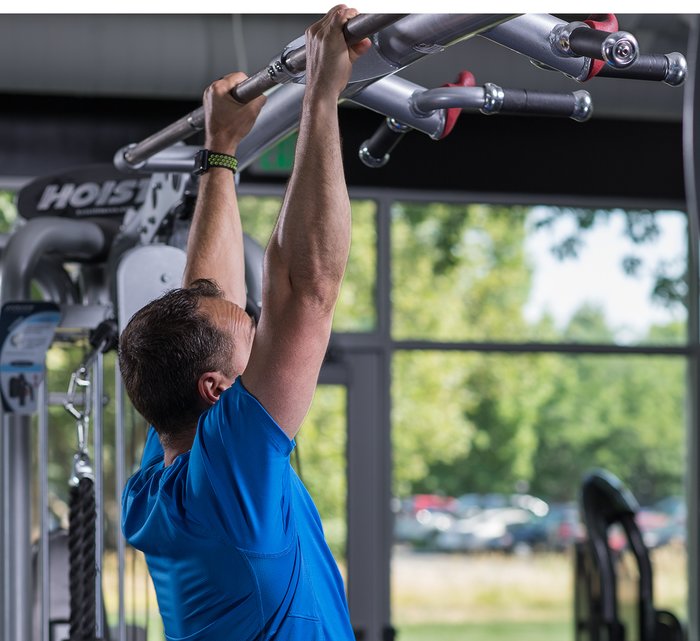
There is no exact standard for how many you should be able to do; you'll have to define your own personal standard for this. I consider 10 the number I'm not willing to go below—meaning, I always want to be able to do 10 pull-ups—but that's just me. Some of my clients are women in their 40s and 50s who can do five or more solid pull-ups. Personally, I think a guy his 40s would be well-served by being able to do at least 10.
There are exceptions, though. If you weigh 285 pounds at 8 percent body fat, I'll find it in my heart to forgive you if you can't do 10. And I also don't think you need to do only a certain type of pull-up for it to "count."
Why Pull-ups Still Matter
In addition to the pull-up being a great drill for the latissimus dorsi and biceps muscles, it is also a very telling fitness standard.
As I recently discussed on the Bodybuilding.com podcast, if you tell me that you can squat "X" amount of weight, I still know almost nothing about you, because I don't know what you mean by "squat". You might be doing partner-assisted quarter reps on the Smith machine with heavy knee wraps, or rock-solid, deep reps with a barbell on your back—or many variations somewhere between those two.
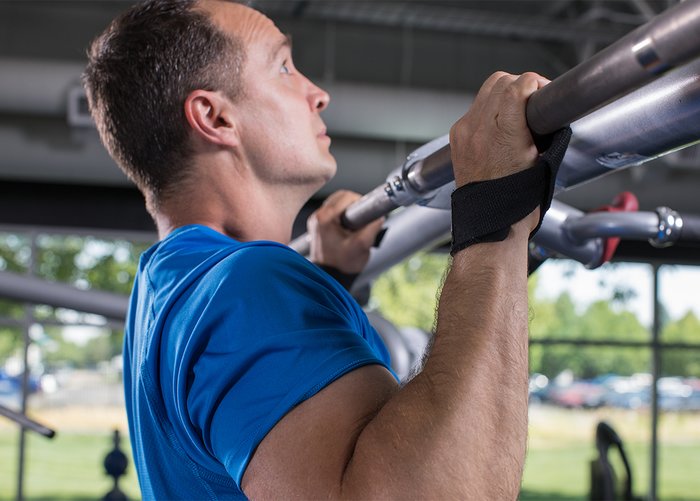
But if you tell me you can do, say, 15 pull-ups or chin-ups, I now know some important things about you and your habits. One of those things is your body composition: anyone who can do a lot of pull-ups is very likely lean and relatively muscular.
That's the "why." Now here's the "how" to improve your pull-up game at every age.
The Essentials of Pull-up Training
One reason pull-ups are a great move is because they're tough! And you can definitely set yourself up to fail in your training with them. No matter how many you can do—or whether you can't do any—give yourself a fighting chance by following these pull-up priorities.
- Use your strongest grip. This will likely be either a supinated (palms facing you) grip or a close, parallel grip. Try both and see which is strongest for you, then stick with that for the early outing. In my book, these variations definitely both count as pull-ups!
- Stop short of your limit. In the case of guys who can currently do maybe 3-4 pull-ups, do a few sets of 1-2 rather than going to or near failure for just a set or two.
- Don't hesitate to use lifting straps. This may seem like blasphemy to some, but it's a game changer for many people. At least initially, don't let your grip strength limit your output.
- Put your mind in the right place. Picture yourself pulling your elbows down to your ribs, rather than thinking about bending your elbows or raising your chin over the bar. This helps to engage the bigger, stronger lat muscles rather than your biceps, which are relatively small and weak.
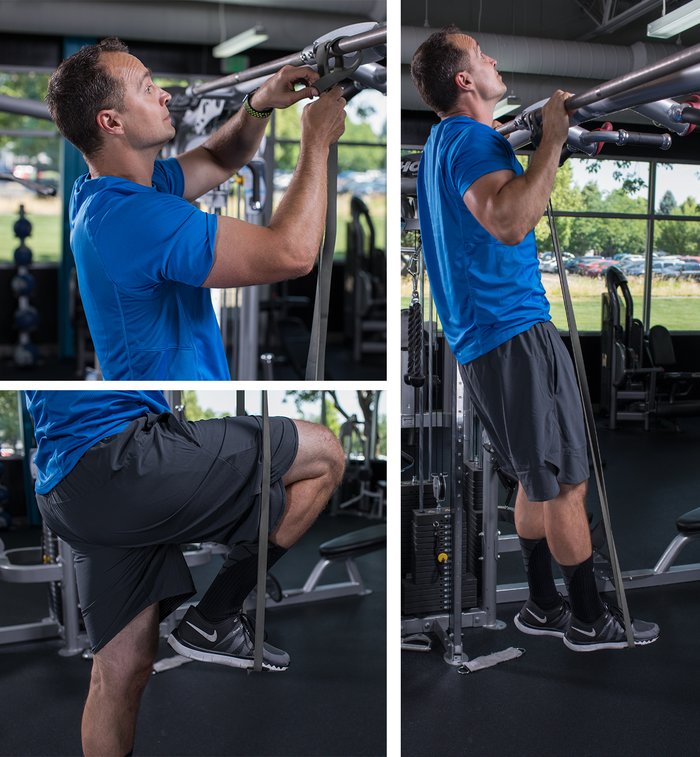
Band-Assisted Pull-Up
If your current pull-up ability hovers around 0-1 reps, try a few of these drills:
- Faux Eccentrics: Rather than starting from a dead hang, start by lowering yourself from about a quarter of the way up, down to an arm-straight position, then start your pull-up. This way, you'll benefit from what's called the "stretch-shortening cycle." This simply means that you can create a more forceful concentric contraction if you put the muscle on a brief stretch first. Think about how you'd throw a ball: you "wind up" your arm behind you—that's the brief stretch—then you throw. Try to recreate this action when you do a pull-up.
- Negative-Only Pull-ups: Stand on a box high enough to allow yourself to start with your chin over the bar, then slowly—over 3-5 seconds, ideally—lower yourself down until your arms are fully straight. Note: As you do this, pay attention to the weakest segment of the movement, then on subsequent reps, emphasize that segment by trying to move more slowly through it.
- Band-Assisted Pull-ups: Either attach the band to the pull-up bar itself and put your feet in the loop, or (my preferred choice) stretch it horizontally on a squat rack. This way, the higher it's placed, the more support it'll deliver. In either case, be mindful of progression. As soon as the reps start to become easier, reposition or choose a heavier band to increase the challenge.
- Partial Pull-ups: These can be done by standing on a platform, which removes the lower aspect of the range of motion, or by performing a partial jump to help you complete the concentric part of the rep. In either case, complete the eccentric portion of the rep under full control.
- Pull-up Assistance Machine: These machines allow you to displace a percentage of your bodyweight as you kneel on a padded platform during pull-ups. For them to work, though, you need to both enforce progression, and keep your technique strict.
What About Lat Pull-Downs?
The lat pull-down is a worthy exercise, but no, I don't think it is "enough" on its own. It can definitely go hand-in-hand with your pull-up training, though, either on the same day or a different day.
The secret to getting the most from pull-downs is to make them mimic the pull-up as closely as possible—which includes going heavy, by the way. Use the same grip, don't allow yourself to lean back, basically make it look and feel exactly like a pull-up. As a pull-up "assistance exercise," you could do a lot worse!
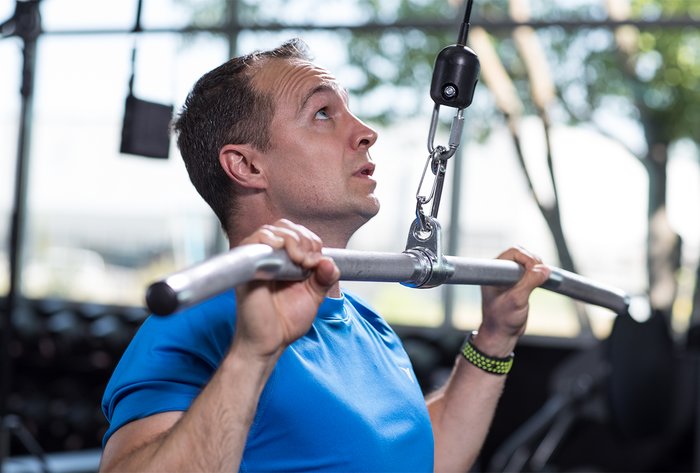
Honestly, if you're really just concerned with the size and strength of your lat muscles, it can make sense for the lat pull-down to be as central—or more central—to your training than pull-ups.
But if you can do pull-ups in one form or another…why wouldn't you? Even just as a gauge of how your training is going, this movement is still one of the best there is. No matter your age, I'd suggest you keep tabs on your numbers, and try to inch them upward.
Best of luck, and if you have additional questions or comments, please post them below.

